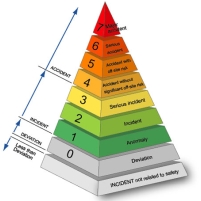Japan Reactor Emergency Passes Three Mile Island on Scale of Nuclear Disasters
Thursday, March 17, 2011

The nuclear crisis in Japan is now considered more severe than the Three Mile Island accident that took place four decades ago in the United States, according to an international regulatory body.
Nuclear accidents are rated on a scale of one to seven by the International Atomic Energy Agency (IAEA) on its International Nuclear and Radiological Event Scale (INES). A 4 is an “accident with local consequences”; a 5 is an “accident with wider consequences”; a 6 is a “serious accident”; and a 7 is a “major accident.”
The 1979 Three Mile Island accident, in which a nuclear reactor in Pennsylvania experienced a partial core meltdown, earned an INES score of five.
The IAEA currently has the disaster at the Fukushima Dai-ichi nuclear plant in northeastern Japan at a six, which puts it in the league of a 1957 incident in Russia in which dried radioactive waste at the Mayak Nuclear Power Plant exploded, spreading a radioactive cloud over an area of hundreds of miles and causing at least 200 cancer deaths.
But the Japanese situation could rival the worst ever recorded, at Chernobyl in the former Soviet Union in 1986, if one or more of the reactors at Fukushima melt down or if disposed nuclear fuel at the plant goes up in flames.
Chernobyl was history’s only seven.
“This is definitely in the Chernobyl league now,” Frank von Hippel, a nuclear physicist at Princeton University, told The Christian Science Monitor. “If the reactors go, that’s bad, of course. But the real concern at this point is if those...spent-fuel pools catch fire. There are many Chernobyls’ worth of radioactive material in there.”
-Noel Brinkerhoff, David Wallechinsky
Nuclear Emergency Is Worst in Decades (by Anahad O’Connor, New York Times)
Japan Nuclear Crisis Eclipses Three Mile Island, Nears 'Chernobyl League' (by Mark Clayton, Christian Science Monitor)
INES (International Atomic Energy Agency)
- Top Stories
- Unusual News
- Where is the Money Going?
- Controversies
- U.S. and the World
- Appointments and Resignations
- Latest News
- Trump Goes on Renaming Frenzy
- Trump Deports JD Vance and His Wife
- Trump Offers to Return Alaska to Russia
- Musk and Trump Fire Members of Congress
- Trump Calls for Violent Street Demonstrations Against Himself






Comments